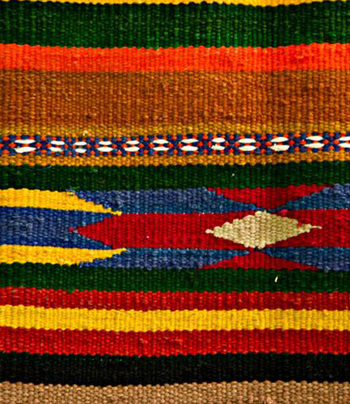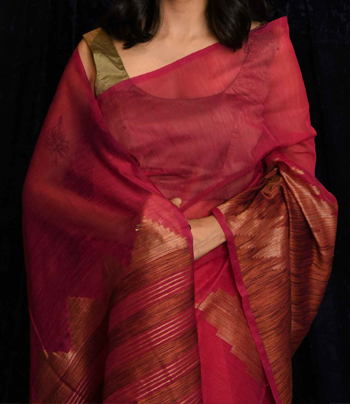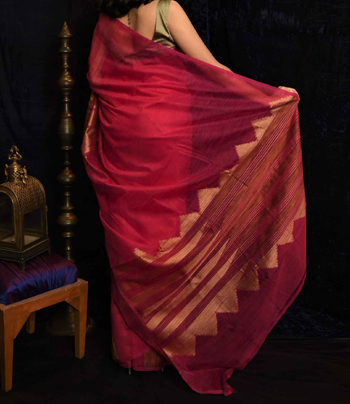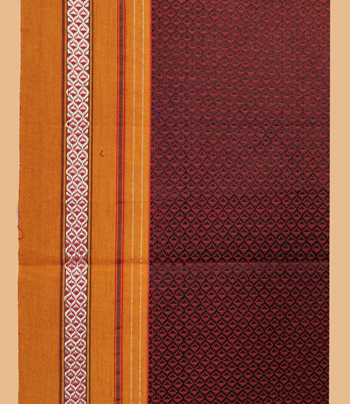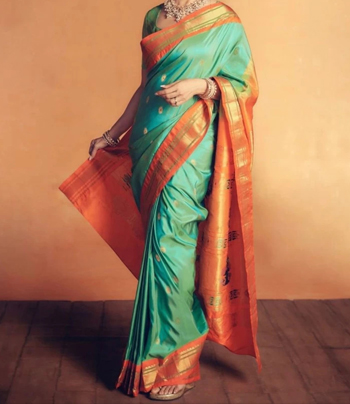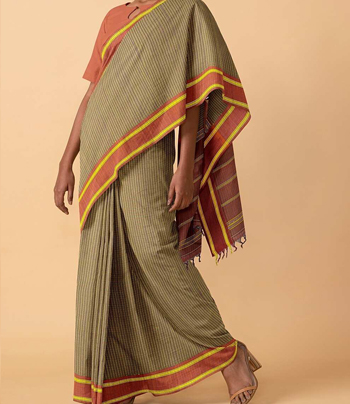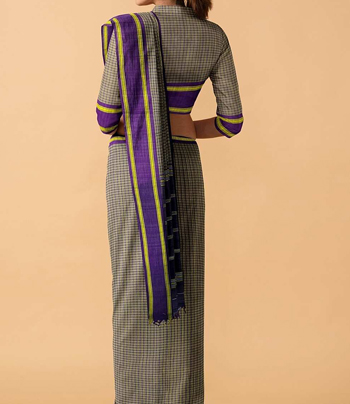Navalgund Durries
Navalgund in Karnataka produces a beautiful masterpiece in form of durries and known all over as Navalgund Durries. The Rugs, carpets and durries woven by the artisans of Navalgund have been produced from generation to generation and hence bears a legacy of production and product specification not found in any other part of the world. The artisan weaves three types of durries namely Navalgund Jamkhan, JaNamaz-Ja-Namaz and Guddar.
The origin of Navalgund Durries can be traced back to a group of weavers who originally migrated from Bijapur to Navalgund. These people had been staying and working in “Jamkhan Galli” of Bijapur. (Now there is nothing except Jamkhan Galli.) When Ali-Adil-Shah was ruling over the region (1558-1580 A.D.) a battle was fought between Vijayanagar dynasty and Ali-Adil-Shah who was helped by Nizamshah of Ahmednagar, Kutubshah from Golconda, Baridshah from Bidar and Bira’s Imam shah. Jamkhans weavers were among the people who left Bijapur and migrated to other places, which were safer. These weavers came to Navalgund selling pearls. They settled down there and set up their looms and started weaving.
Ilkal Sarees
Ilkal is a medium-sized town in Bagalkot district. The town is located in a valley that lies in the South – East corner of Bagalkot district and is quite close to the borders of Kushtagi taluk of Koppal district. The town falls within the jurisdiction of Hungund taluk and lies at a distance of about 12 Kms south of taluk headquarters. Between these two towns, Ilkal is an important centre of trade, commerce and industry.
Ilkal sarees are woven using cotton warp on the body and art silk warp for border and art silk warp for pallu portion of the saree. In some cases instead of art silk, pure silk is also used. The general construction particulars followed at Ilkal for the past years are given in the page 3 of 28. The peculiar characteristic of the saree is joining the body warp with the pallu warp which is locally called as TopeTeni. This technique is only used exclusively at Ilkal. If anyone requires Ilkal saree one must prepare a warp for every saree. Warp threads for the body are prepared separately. Similarly pallu warp is prepared separately either with art silk or pure silk depending upon the quality required. Thirdly, the border portion of the warp is prepared like the pallu warp either art silk or pure silk and the colour used for pallu and on the border will be one and the same. In general, the length of the palau will range 16” to 27”.
Guledgudd Khana
The blouses made out of Guledgudd Khana (or dyed fabric) compliments the Ilkal Sarees as this combination is widely used not only in the northern part of Karnataka but the Marathawada and Vidarbha regions of Maharashtra also. The Ilkal Sarees and Guledgudd Khana in their best combinations are used extensively in Urban and Rural parts of Karnataka and Maharashtra. The unique designs produced by using dyed yarns represent the traditions followed by people of some regions of Karnataka and Maharashtra states. The motives used for the designs in Guledgudd cluster are extracted from nature, ancient stone sculptures of Badami and from the Hindu Mythology. These designs are well accepted by the people in this region and they have a strong belief in them. These Khana materials are manufactured approximately for the last 200 years and till today they are so popular that, except these traditional designs no ot her designs are accepted by the users of Khana.
Molakalmuru Sarees
Molakalmuru Pure silk sarees details: Molakalmuru silk sarees are known for sheer texture and appearance. (2) In the sarees – body, pallav and border portion –warp and weft yarn used are twisted pure silk yarn of different configurations and varieties. (3) Contrast colours are used in borders and pallav portion as compared to body portion and which is one of the hall marks of Molakalmuru sarees and to give a fine shot effect to the body. Tie and dye method is used and practiced locally to get the effect of contrast colour of body and Pallav portion of the saree. This process is an unique one for Molakalmuru sarees. (5)Contrast border is woven by Korvai technique of weaving on either side of the saree. Traditional silk saree is woven with 3 shuttle work with Solid Border, Solid Pallav and Solid Body. (6)Molakalmuru saree warp is twisted silk and no size is applied .(7) In traditional Molakalmuru silk saree, though it is a 3 shuttle work , the border is woven with same colour for both warp and weft where as the body is woven with a contrast colour so that of the body warp to give a fine shot effect with body. The colour of the Pallav warp and weft is same as that of border colour . This is done by tie and dye technique.(8) The main colours used for sarees are Maroon, Red, Blue, Green, Yellow, Snuff, Pink and colour combinations are made by sheer experience of weavers.(9) Total length of silk saree with blouse is 6.20 meters or 6.75 yards; width 48” to 50”(10) Weight of sarees varies from 450 gms to 1200 grms. (11)DESIGNS: Traditional designs used are (i) Hamsa, (ii) Rudrakshi, (iii) Vanki, (iv) Lotus, (v) Peacock, (vi) Mangoes.vii) Gandeberunda etc. Normally the designs in the border are in two stripes. (12) Stripes;Check pattern designs with butta design are used in the body.A total of above 3500 traditional weavers are engaged in and around Molakalmuru taluk.
Udupi Sarees
The hank yarn dyed (or coloured) and hand-woven Saree, known as Udupi Saree, is the major traditional product manufactured in the Dakshina Kannada and Udupi districts of Karnataka. These Sarees are produced either with check design in the body with solid border or Plain Saree with Butta designs. The major items manufactured in the handloom sector in the Dakshina Kannada and Udupi districts vary from products made out of fine cotton yarn to coarser yarn. Though the products like lungi, Bairas (Towel), etc. are produced in the cluster, Udupi Sarees are the most famous hand-woven item produced here. The traditional Udupi Sarees are woven with coloured cotton yarn (dyed yarn) of finer counts along with coloured art-silk yarn and half fine zari.

